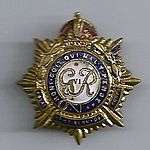Royal Army Service Corps
| Royal Army Service Corps | |
|---|---|
|
George VI Royal Army Service Corps badge. Motto: Honi soit qui mal y pense | |
| Active | 1888-1965 |
| Allegiance |
|
| Branch |
|
| Role | Military administration |
| Garrison/HQ | Buller Barracks, Aldershot |
| Nickname(s) | The Moke Train or the Commos |
| Motto(s) | In Arduis Fidelis (Faithful in Adversity) |
| March | Wait for the Wagon |
The Royal Army Service Corps (RASC) was a corps of the British Army responsible for land, coastal and lake transport, air despatch, barracks administration, the Army Fire Service, staffing headquarters' units, supply of food, water, fuel and domestic materials such as clothing, furniture and stationery and the supply of technical and military equipment. It became a "Forming Corps" of the Royal Logistic Corps.
History
For centuries, army transport was operated by contracted civilians. The first uniformed transport corps in the British Army was the Royal Waggoners formed in 1794. It was not a success and was disbanded the following year. In 1799, the Royal Waggon Corps was formed; by August 1802, it had been renamed the Royal Waggon Train. This was reduced to only two troops in 1818 and finally disbanded in 1833.
A transport corps was not formed again until the Crimean War. In 1855, the Land Transport Corps was formed. This was renamed the Military Train the following year.
In 1869, there was a major reorganisation of army supply and transport capabilities. Before 1869, supply duties had been the responsibility of the Commissariat, a uniformed civilian body. In 1869, the commissaries of the Commissariat and the officers of the Military Train amalgamated into the Control Department. The following year the other ranks of the Military Train were redesignated the Army Service Corps (ASC), officered by the Control Department. In November 1875, the Control Department was divided into the Commissariat and Transport Department and the Ordnance Store Department (which developed into the Royal Army Ordnance Corps). In January 1880, the Commissariat and Transport Department was renamed the Commissariat and Transport Staff and the Army Service Corps was renamed the Commissariat and Transport Corps. Finally, in December 1888, these two bodies amalgamated with the War Department Fleet to form a new Army Service Corps, and for the first time officers and other ranks served in a single unified organisation.

The ASC subsequently absorbed some transport elements of the Royal Engineers. In 1918, the corps received the "Royal" prefix for its service in the First World War and became the Royal Army Service Corps. It was divided into Transport and Supply Branches.
Before the Second World War, RASC recruits were required to be at least 5 feet 2 inches tall and could enlist up to 30 years of age (or 35 for tradesmen in the Transport Branch). They initially enlisted for six years with the colours and a further six years with the reserve (seven years and five years for tradesmen and clerks, three years and nine years for butchers, bakers and supply issuers). They trained at Aldershot.[1]
Alone among the "Services" (i.e. rear echelon support corps), RASC personnel were considered to be combatant personnel.[2]
In 1965, the RASC was merged with the Transportation and Movement Control Service of the Royal Engineers (which was responsible for railway transport, inland water transport, port operations, and movements) to form the Royal Corps of Transport. All its supply functions,(including the supply of vehicles, their care and preservation in storage and delivery), along with the staff clerks, were transferred to the Royal Army Ordnance Corps, leaving the new RCT solely responsible for transport and movements. In 1993, the RCT and RAOC were merged to form the Royal Logistic Corps, the modern descendant of the ASC.
Ranks
Officers of the Control Department, Commissariat and Transport Department, and Commissariat and Transport Staff held different ranks from the rest of the Army.[3][4] From February 1885 they were given honorary military ranks, which they held in conjunction with their commissary ranks.[5] Officers of the ASC and RASC held full military rank.
| Army rank | Control Department rank | Commissariat & Transport Department rank | Commissariat & Transport Staff rank |
| Second Lieutenant | Sub-Assistant Commissary | Sub-Assistant Commissary | Quartermaster |
| Lieutenant | Assistant Commissary | Assistant Commissary | Deputy Assistant Commissary-General |
| Captain | Deputy Commissary | Deputy Commissary | Deputy Assistant Commissary-General |
| Major | Commissary | Commissary | Assistant Commissary-General |
| Lieutenant-Colonel | Assistant Controller | Assistant Commissary-General | Assistant Commissary-General |
| Colonel | Deputy Controller | Deputy Commissary-General | Deputy Commissary-General |
| Controller | Commissary-General | Commissary-General |
Notable personnel
- Category:Royal Army Service Corps soldiers
- Category:Royal Army Service Corps officers
See also
- 15 Air Assault Close Support Squadron RLC
- Cathedral of St Michael and St George, Aldershot (annual service, East Window, and photo of memorial chapel)
Footnotes
- ↑ War Office, His Majesty's Army, 1938
- ↑ War Office, Royal Warrant for the Pay, Appointment, Promotion and Non-Effective Pay of the Army, 1931
- ↑ "No. 24281". The London Gazette. 4 January 1876. p. 4.
- ↑ "No. 24822". The London Gazette. 12 March 1880. p. 2016.
- ↑ "No. 25444". The London Gazette. 20 February 1885. p. 760.
External links
| Wikimedia Commons has media related to Royal Army Service Corps. |
